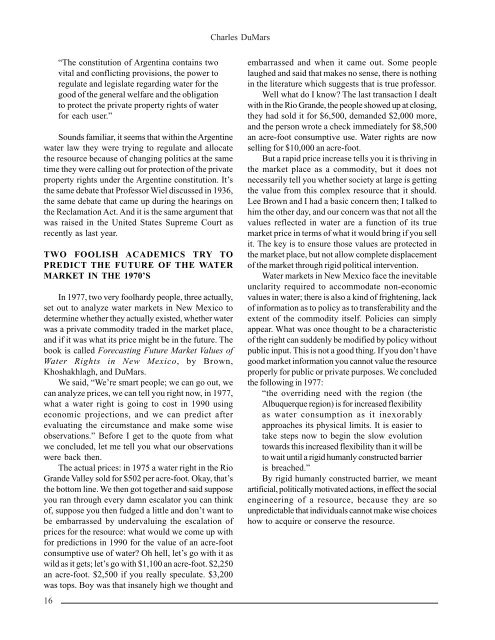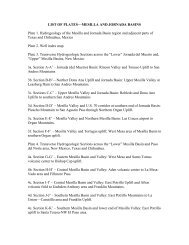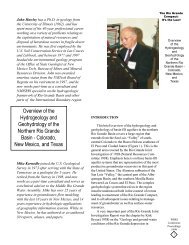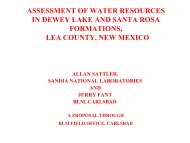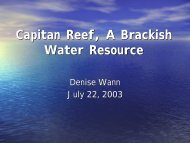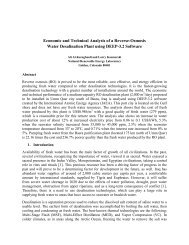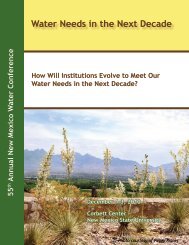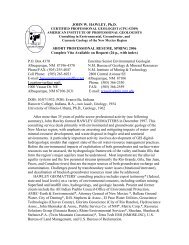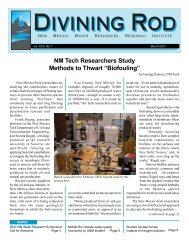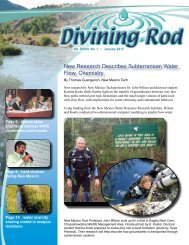Charles T. DuMars - Water Resources Research Institute
Charles T. DuMars - Water Resources Research Institute
Charles T. DuMars - Water Resources Research Institute
Create successful ePaper yourself
Turn your PDF publications into a flip-book with our unique Google optimized e-Paper software.
<strong>Charles</strong> <strong>DuMars</strong><br />
16<br />
“The constitution of Argentina contains two<br />
vital and conflicting provisions, the power to<br />
regulate and legislate regarding water for the<br />
good of the general welfare and the obligation<br />
to protect the private property rights of water<br />
for each user.”<br />
Sounds familiar, it seems that within the Argentine<br />
water law they were trying to regulate and allocate<br />
the resource because of changing politics at the same<br />
time they were calling out for protection of the private<br />
property rights under the Argentine constitution. It’s<br />
the same debate that Professor Wiel discussed in 1936,<br />
the same debate that came up during the hearings on<br />
the Reclamation Act. And it is the same argument that<br />
was raised in the United States Supreme Court as<br />
recently as last year.<br />
TWO FOOLISH ACADEMICS TRY TO<br />
PREDICT THE FUTURE OF THE WATER<br />
MARKET IN THE 1970’S<br />
In 1977, two very foolhardy people, three actually,<br />
set out to analyze water markets in New Mexico to<br />
determine whether they actually existed, whether water<br />
was a private commodity traded in the market place,<br />
and if it was what its price might be in the future. The<br />
book is called Forecasting Future Market Values of<br />
<strong>Water</strong> Rights in New Mexico, by Brown,<br />
Khoshakhlagh, and <strong>DuMars</strong>.<br />
We said, “We’re smart people; we can go out, we<br />
can analyze prices, we can tell you right now, in 1977,<br />
what a water right is going to cost in 1990 using<br />
economic projections, and we can predict after<br />
evaluating the circumstance and make some wise<br />
observations.” Before I get to the quote from what<br />
we concluded, let me tell you what our observations<br />
were back then.<br />
The actual prices: in 1975 a water right in the Rio<br />
Grande Valley sold for $502 per acre-foot. Okay, that’s<br />
the bottom line. We then got together and said suppose<br />
you ran through every damn escalator you can think<br />
of, suppose you then fudged a little and don’t want to<br />
be embarrassed by undervaluing the escalation of<br />
prices for the resource: what would we come up with<br />
for predictions in 1990 for the value of an acre-foot<br />
consumptive use of water Oh hell, let’s go with it as<br />
wild as it gets; let’s go with $1,100 an acre-foot. $2,250<br />
an acre-foot. $2,500 if you really speculate. $3,200<br />
was tops. Boy was that insanely high we thought and<br />
embarrassed and when it came out. Some people<br />
laughed and said that makes no sense, there is nothing<br />
in the literature which suggests that is true professor.<br />
Well what do I know The last transaction I dealt<br />
with in the Rio Grande, the people showed up at closing,<br />
they had sold it for $6,500, demanded $2,000 more,<br />
and the person wrote a check immediately for $8,500<br />
an acre-foot consumptive use. <strong>Water</strong> rights are now<br />
selling for $10,000 an acre-foot.<br />
But a rapid price increase tells you it is thriving in<br />
the market place as a commodity, but it does not<br />
necessarily tell you whether society at large is getting<br />
the value from this complex resource that it should.<br />
Lee Brown and I had a basic concern then; I talked to<br />
him the other day, and our concern was that not all the<br />
values reflected in water are a function of its true<br />
market price in terms of what it would bring if you sell<br />
it. The key is to ensure those values are protected in<br />
the market place, but not allow complete displacement<br />
of the market through rigid political intervention.<br />
<strong>Water</strong> markets in New Mexico face the inevitable<br />
unclarity required to accommodate non-economic<br />
values in water; there is also a kind of frightening, lack<br />
of information as to policy as to transferability and the<br />
extent of the commodity itself. Policies can simply<br />
appear. What was once thought to be a characteristic<br />
of the right can suddenly be modified by policy without<br />
public input. This is not a good thing. If you don’t have<br />
good market information you cannot value the resource<br />
properly for public or private purposes. We concluded<br />
the following in 1977:<br />
“the overriding need with the region (the<br />
Albuquerque region) is for increased flexibility<br />
as water consumption as it inexorably<br />
approaches its physical limits. It is easier to<br />
take steps now to begin the slow evolution<br />
towards this increased flexibility than it will be<br />
to wait until a rigid humanly constructed barrier<br />
is breached.”<br />
By rigid humanly constructed barrier, we meant<br />
artificial, politically motivated actions, in effect the social<br />
engineering of a resource, because they are so<br />
unpredictable that individuals cannot make wise choices<br />
how to acquire or conserve the resource.


